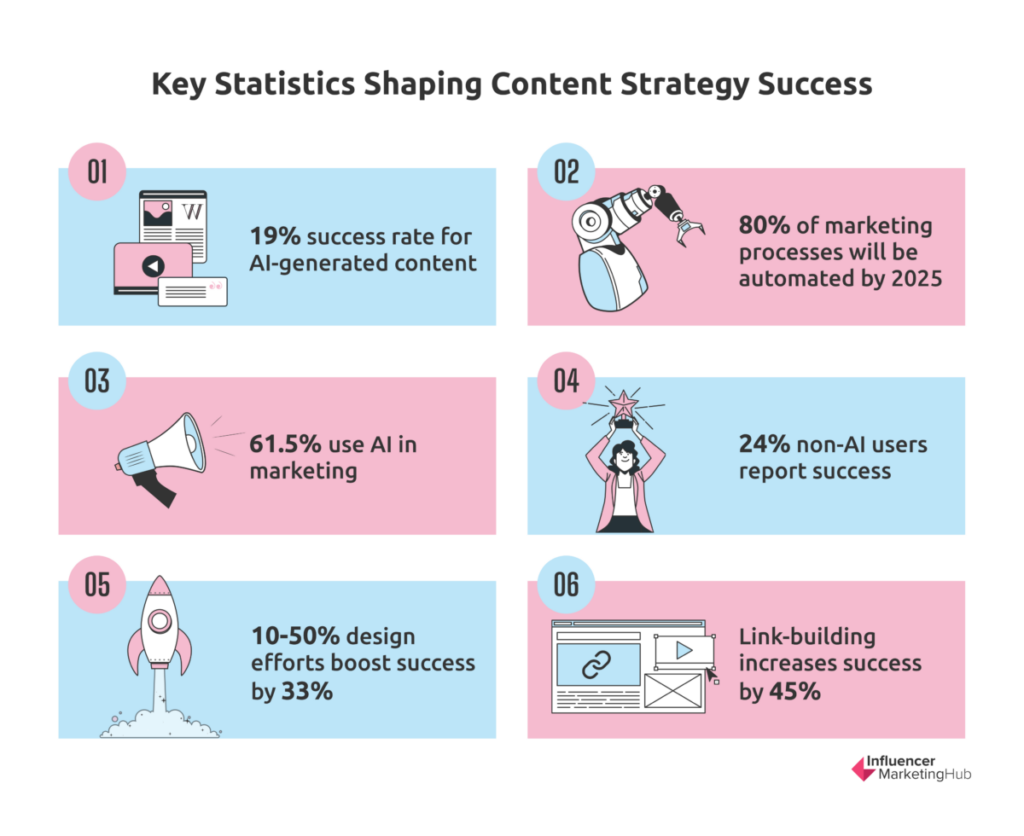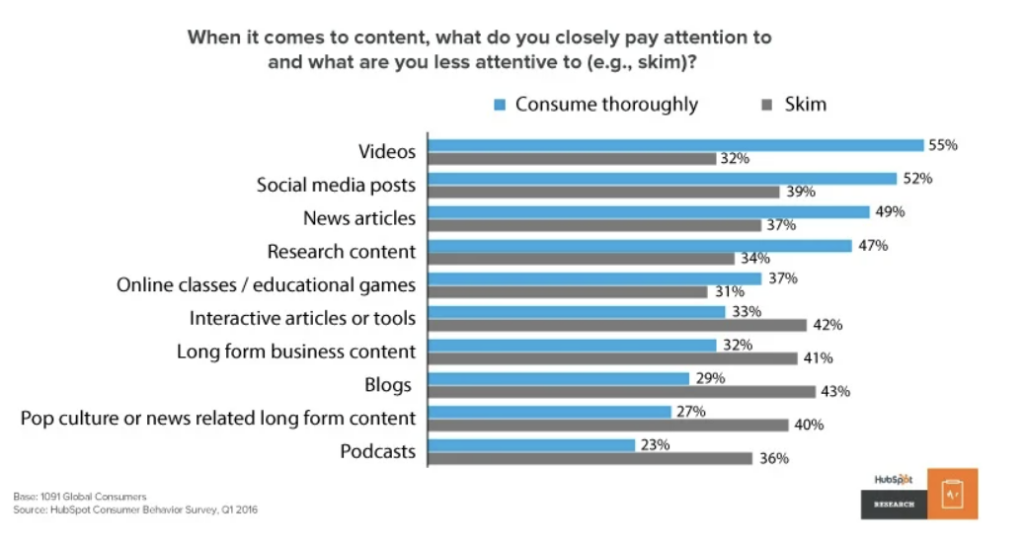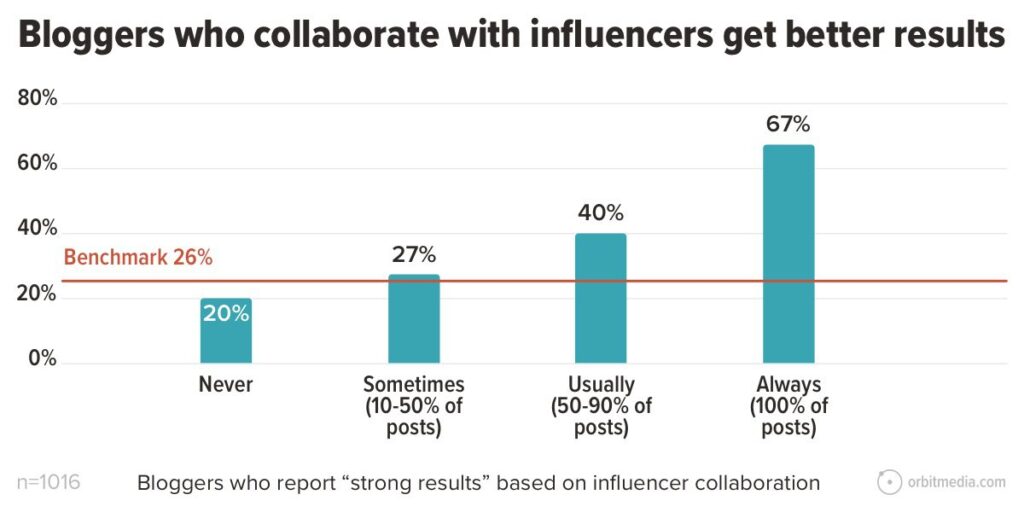Today, businesses of any size can easily fall behind their competitors if they’re not producing online content. However, content marketing is more than just posting trendy TikTok videos or using viral hashtags. Content must be carefully crafted, curated, up-to-date, and tailored to the brand’s target audience.
Quality is also crucial; the higher the quality of its content, the higher a site’s ranking on search engines will be. Users are also more likely to trust high-quality, authoritative content than mediocre, “spammy” ones.
Content marketing is still highly invaluable in 2024, with so much noise online and competition further strengthening digital tactics. To stand out, your content must not only follow trends, but also be the result of the right strategies and be published on the proper channels.
To get your content marketing strategy right in 2024, review the key statistics we’ve rounded up for this year.
Nail Your Content Marketing Plan: 13 Content Marketing Statistics in 2024 + Tips for Success:
- 1. 19% of businesses that use AI to generate content report success
- 2. 24% of businesses that don’t use AI to generate content also report success
- 3. Businesses dedicating 10-50% of their content efforts toward design are 33% more likely to reach success
- 4. Businesses leveraging link-building are 45% more successful than those that don’t
- 5. The top three types of content are interactive content, behind-the-scenes info, and content related to a brand’s values
- 6. Articles with videos drive 70% more traffic than those without
- 7. 89% of people who have watched a video were convinced to buy a product or service
- 8. 93% of businesses acquired a new customer after sharing a video on social media
- 9. Consumers watch videos the most on Facebook, YouTube, and TikTok
- 10. How-to videos are consumers’ favorite type of content
- 11. Blogs have an average bounce rate of 82.4%
- 12. 43% of users only skim blog posts
- 13. Blogs made in collaboration with influencers get more engagement
Content Strategy Statistics Worth Noting
There are a number of tools available to help you set up an effective content strategy. These include design tools, SEO, and, more recently, artificial intelligence (AI). Let’s see what studies have found about these strategies.

1. 19% of businesses that use AI to generate content report success
It seems like the AI craze—specifically with ChatGPT—will not dwindle anytime soon. This statistic from Siege Media and Clearscope shows that AI has become a game changer in content strategy. Using AI for content generation might have drawn mixed reactions, but one thing’s for certain: AI will only become more powerful in the future, so it’s clever to embrace and take advantage of it.
A report from Gartner showed that 80% of marketing processes will be automated with AI technologies by 2025. In addition, the AI Marketing Survey by Influencer Marketing Hub revealed that 61.5% of respondents have used or are using AI in their marketing operations.
Aside from ChatGPT, there are many more free AI marketing tools available, such as Rytr, Unbounce, and Writesonic. These tools can help you craft catchy and engaging product descriptions, brainstorm blog ideas, and improve the quality of your content. They also offer paid versions, which allow you to make more complex prompts and generate more sophisticated content.
2. 24% of businesses that don’t use AI to generate content also report success
On the flip side, sticking to the more traditional means of generating content will not automatically put you behind the game. According to Siege Media and Clearscope, 24% of businesses that don’t use AI for content generation are still successful.
While AI can definitely make content generation more efficient, automation is not the only factor that determines your content strategy’s success. You can also develop an effective marketing strategy by focusing on other areas, such as building trust and relationships with your customers, enhancing your service quality, and maintaining a solid brand identity. However, it's important to note that AI now holds a valuable role in content creation as they empower businesses to boost efficiency and productivity.
Overall, the key to a successful content strategy is delivering value to customers, whether it’s through AI or any other means.
3. Businesses dedicating 10-50% of their content efforts toward design are 33% more likely to reach success
Siege Media and Clearscope’s report also showed that a well-designed content strategy could help businesses reach their goals. Companies that made significant efforts for their content’s design appeared quite likely to report successful results.
Good design is indeed one of the factors that contribute to a successful content strategy. Businesses with well-designed content can catch people’s attention better and keep it. They can also boost their brand image and build trust with their customers.
So if your content strategy seems to be missing something, consider allocating more time and resources to design. Make every piece of content visually appealing, use high-quality images or videos, and stick to your brand’s colors. The copy is also critical when designing content; avoid technical jargon if you can so that your copy is clear, concise, and digestible to the average audience.
Lastly, a well-designed content includes a call-to-action (CTA) that should encourage your audience to take the next step, whether it’s reading your full blog, ordering a product, buying a subscription, or simply visiting your website.
4. Businesses leveraging link-building are 45% more successful than those that don’t
Link-building is an SEO strategy where you strive to get other websites to post links to your website. Businesses used to execute this strategy through link farms, but this approach is now outdated as Google has started penalizing websites that use link farms. In 2024, SEO experts are more focused on ethical link-building, meaning businesses should now earn backlinks from other websites instead of simply spamming their links everywhere they can.
Siege Media and Clearscope report that businesses that correctly use link-building can have a 45% higher success rate than businesses without any link-building strategy. There are many link-building tools that allow you to build links ethically, such as SEMrush, Linkody, Majestic, Ahrefs, and more. These tools let you find link-building opportunities, track backlinks, analyze links, and vet links.
5. The top three types of content are interactive content, behind-the-scenes info, and content related to a brand’s values
According to HubSpot, interactive content, behind-the-scenes info, and content that communicates a brand’s values are the three best-performing types of content.
This is not surprising. Interactive content engages users through fun activities like quizzes, surveys, or games. Leveraging interactive content is a great way to get to know your audience.
Behind-the-scenes info, on the other hand, gives your audience a glimpse of your company’s culture and values. Now that consumers are growing more conscious and selective about the brands they support, they are eager to know their favorite brands’ business practices and form judgments from there.
For that reason, any content that communicates a brand’s values also draws a lot of engagement. If your brand’s values align with your customers’, you can connect with them on a deeper level and even earn their loyalty. You can also advocate for the same cause, helping build stronger trust.
Video Content Marketing Statistics
With TikTok, Instagram Reels, and YouTube Shorts taking the Internet by storm, posting videos can now amp up your content marketing efforts. Here are some noteworthy video content marketing statistics from esteemed researchers.

6. Articles with videos drive 70% more traffic than those without
SEMrush found that articles with at least one video drive 70% more traffic than those without. This is because well-made videos are more engaging and informative than plain text.
In addition, videos can tell stories, explain complex concepts, and teach people how to do things. But you need to make sure that your videos are professionally produced. The audio should be crisp and clear, while the motion graphics themselves should be of high quality. It’s also wiser to keep your videos short; the rise of short-form videos has made people more likely to finish watching short videos than long-form ones.
Don’t forget to add a CTA, too. Besides informing, teaching, or simply engaging the audience, a video should also encourage your audience to take action.
7. 89% of people who have watched a video were convinced to buy a product or service
According to a study by Wyzowl, a whopping 89% of people reported that watching a video has convinced them to buy a product or service.
To make a video generate a sale, it should not only be visually appealing, but it should also create a sense of urgency or invoke a fear of missing out. For example, showing that a product is in demand can encourage people to try it out, especially if it’s by a reputable brand. Moreover, videos that explain a product or service thoroughly and state its benefits can urge people to make a purchase.
What’s more, with Wyzowl also revealing that 96% of people watch explainer videos to understand a product or service, it’s no wonder that well-produced videos convince people to spend their money.
8. 93% of businesses acquired a new customer after sharing a video on social media
This statistic from Animoto further stresses how important videos are in content marketing. Videos can engage people in a way static images or blogs can’t. While images and blogs are powerful types of content, videos tend to be more engaging as they can send a message with minimal effort on the consumer’s part.
Videos like behind-the-scenes snippets, interviews, or anything that conveys your brand’s story can also show the human side of your business, making you more approachable to your customers. Some videos, particularly those with viral-worthy elements, can also spark conversations and increase brand awareness.
9. Consumers watch videos the most on Facebook, YouTube, and TikTok
If you want your videos to generate sales, focus on posting on the top 3 channels consumers use: Facebook, YouTube, and TikTok. According to Animoto, they were the channels on which consumers watched videos that prompted purchase.
Posting content on the proper channels is crucial as it allows you to target your desired audience, increasing your chances of hitting your KPIs. So if most of your audience uses Facebook to watch videos, then it makes the most sense for your videos to be posted on Facebook rather than Instagram. Although it would also help to reach out to new customers on another channel, it’s essential to focus more of your efforts on the channels and platforms your customers already use. After all, it’s less expensive to retain customers than to acquire new ones.
10. How-to videos are consumers’ favorite type of content
Animoto’s study also showed that How-to videos are consumers' favorite type of content from brands. How-to videos effectively engage people as they are a more enjoyable alternative to reading lengthy user manuals.
Learning from videos can also save time and money because they allow people to acquire skills they would have otherwise paid other people for. For example, if a person needs to repair a minor issue in their house, a quick tutorial video by a home maintenance company can make them follow easy steps to get the job done. As a result, the person was able to become more efficient with their time, and they gained awareness of the company that taught them how to perform the repairs.
If you’re worried that teaching people DIY skills will discourage them from hiring professionals, that won’t be the case at all. How-to videos can actually benefit your business because they help ensure that you’ll only get more complex jobs, which generate more revenue. Plus, as a professional, you can make better use of your time by focusing on jobs that require your expertise.
Blog Statistics
Blogs are perhaps the most popular component of content marketing. But are they truly effective in generating leads and drawing engagement? Let’s see what the statistics show.

11. Blogs have an average bounce rate of 82.4%
Bounce rates are one of those metrics you don’t want to see increase. Unfortunately, Siege Media found that a blog generates a bounce rate of 82.4% on average. This indicates that many users leave your website after viewing only one page, such as a blog in this case.
Numerous factors can contribute to a high bounce rate, including poor design, irrelevant content, slow loading times, and missing CTAs. To decrease your blog’s bounce rate, you may have to refine your strategy. Focus on your target audience, determine the questions they want answered, identify the information that will help them the most, and share knowledge that isn’t commonly known.
Once you’ve formulated a blogging strategy, draft a compelling headline. It should catch attention without sounding vague or mysterious. If you’re writing a listicle, adding numbers would help as it lets the audience know how many insights they can get from the blog.
It’s also wise to make your blog scannable since online users only read 20% of the text on a page. So stick to short paragraphs, include bullet points where necessary, and don’t hesitate to add white space. They give users a break from a long block of text.
12. 43% of users only skim blog posts

Source: blog.hubspot.com
HubSpot’s study complements the statistic above, showing that 43% of users only skim blogs. This figure further proves that people now gravitate toward the types of content they can consume quickly, like short-form videos. However, it doesn’t mean that blogging has become outdated.
Instead of abandoning blogs, you can tailor them according to your audience’s reading habits. If your analytics data show that blogs with bullet points or videos perform the best, focus on posting similar types of blogs to engage your audience effectively. Make your headlines capture attention and incorporate facts into your content to make your blogs more impactful, encouraging your customers to heed your CTA.
13. Blogs made in collaboration with influencers get more engagement

Source: orbitmedia.com
A study by Orbit Media showed that consistent collaboration with influencers and experts allows blogs to draw more engagement. Since they result in content with multiple perspectives, they tend to be more compelling. Not to mention users who follow influencers are surely interested in their views regarding any topic.
Businesses can publish collaborative blogs by allowing guest posts from journalists. Meanwhile, bloggers can ask other, more well-known bloggers to contribute to their content.
The Future of Content Marketing
These statistics we’ve gathered show that the future of content marketing is bright. However, videos are evidently the superior type of content with their ability to inform, educate, engage, and persuade.
AI is also showing a promising future in content marketing. With ChatGPT on the rise, it’s likely that other free AI resources will hog the spotlight soon. In fact, Bard, Google’s experimental conversational AI service, has been making headlines recently and is heavily compared with ChatGPT.
From these ongoing developments, it won’t be surprising if other AI tools go viral in the future. Although they’ve been around for several years now, it’s only recently that they started to gain traction, allowing more individuals and businesses to understand the technology more deeply. And because many AI tools are free, businesses don’t have to make financial commitments to start leveraging them. In just a few clicks, they can generate content, engage better with customers, and do research.
Nailing Your Content Marketing Plan in 2024
The rapid rise of video and AI marketing shouldn’t discourage businesses from posting blogs. Blogging isn’t likely to go out of fashion as the most popular component of content marketing. People have simply changed the way they consume blogs. Nowadays, they prefer them to be scannable and digestible. But if you want to make more impact with your content marketing strategy, videos are the way to go.
Educate your audience with how-to videos, and form relationships by showing your brand’s journey. No matter what happens in content marketing, people love stories that tug at their heartstrings, so instead of simply selling, focus on telling a story. If you successfully connect with your audience, your business will become more trustworthy, increasing your odds of making a sale.


